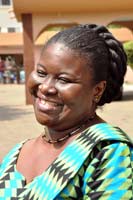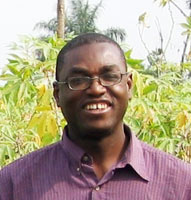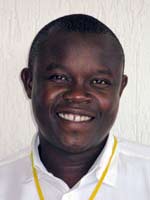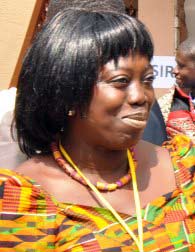Collective action to boost cassava yields in Africa
- Tuesday, 27 July 2010 13:38
Download E-publication
Accra, Ghana, was the venue of the 3rd annual meeting of Africa’s cassava breeders’ Community of Practice (CoP), held from 19th to 22nd July 2010. “By sharing practical knowledge, field experiences and strategies, the CoP provides a functional inter-institutional framework for regional cooperation in research for development,” says Dr Emmanuel Okogbenin of Nigeria’s National Root and Tuber Crops Research Institute (NRCRI), and who coordinates the CoP. It brings together breeders from Ghana, Nigeria, Tanzania and Uganda.
 The meeting was facilitated and funded by the Generation Challenge Programme (GCP) of the Consultative Group on International Agricultural Research (CGIAR), and hosted by Ghana’s Council for Scientific and Industrial Research (CSIR) and CSIR’s Crops Research Institute (CRI). It was opened by Dr Mrs RoseEmma Mamaa Entsua-Mensah (pictured), Deputy Director General, CSIR. She observed that Ghanaian villages growing cassava as the dominant food staple reported famine less frequently than villages where other crops were dominant. However, she lamented that cassava production is hampered by pests and diseases, declining soil fertility, use of low-yielding cultivars and poor agricultural practices.
The meeting was facilitated and funded by the Generation Challenge Programme (GCP) of the Consultative Group on International Agricultural Research (CGIAR), and hosted by Ghana’s Council for Scientific and Industrial Research (CSIR) and CSIR’s Crops Research Institute (CRI). It was opened by Dr Mrs RoseEmma Mamaa Entsua-Mensah (pictured), Deputy Director General, CSIR. She observed that Ghanaian villages growing cassava as the dominant food staple reported famine less frequently than villages where other crops were dominant. However, she lamented that cassava production is hampered by pests and diseases, declining soil fertility, use of low-yielding cultivars and poor agricultural practices.
 By integrating marker-assisted selection (MAS) with conventional breeding and pre-breeding strategies, the CoP teams aim to accelerate production and dissemination of farmer-preferred cassava varieties, resistant to pests and diseases. “That way, we strengthen breeders in both conventional and molecular breeding,” adds Dr Okogbenin (pictured).
By integrating marker-assisted selection (MAS) with conventional breeding and pre-breeding strategies, the CoP teams aim to accelerate production and dissemination of farmer-preferred cassava varieties, resistant to pests and diseases. “That way, we strengthen breeders in both conventional and molecular breeding,” adds Dr Okogbenin (pictured).
Three of the four target countries rank among the top four cassava producers in Africa (Nigeria, Ghana and Tanzania, in that order), while cassava is only second to plantains, and to maize, in Uganda and Tanzania, respectively. In Ghana, cassava ranks first in acreage and utilisation. It has been identified as a crop that can bring about remarkable economic development in the poor regions of Ghana. Cassava is a major food staple food crop, and more than 80 percent of the population relies on cassava as their main carbohydrate source. Nigeria is the world’s top cassava producer and consumer, and cassava is the mainstay and ‘staff of life’ for most poor rural Nigerians. As such, in Nigeria as in other target countries, cassava is a viable vehicle for rapid rural development through food security and income generation, but the road is hardly smooth, and is ridden with roadblocks.
Volatile cocktail of foes old and new
Drought, declining soil fertility, pests and diseases all stand in the way of realising cassava’s full productivity. In fact, some of the pests and diseases can lead to total crop failure. Pests include the cassava green mite (CGM, Mononychellus tanajoa), cassava mealy bug (CMB, Phenacoccus manihoti) and the cassava whitefly (Bemisia tabaci). The whitefly packs a deadly triple punch: besides destroying cassava leaves and young shoot tips, the whitefly is also a vector of the cassava mosaic disease (CMD) and the cassava brown streak disease (CBSD).
“The whitefly was first identified as a pest in the late 1990s. But CMD is an old and unrelenting enemy that has plagued cassava for more than a century now, with yield losses of between 25 and 100 percent,” says Dr Geoffrey Mkamilo of the Agricultural Research Institute (ARI), Tanzania. And that is not all that is stacked against cassava: “There is also CGM which can result in yield losses of up to 85 percent. In addition, in Tanzania, losses of up to 74 percent due to CBSD have been reported,” Dr Mkamilo reveals.
Spreading tentacles
And CBSD is not standing still but on the march in Eastern and Central Africa, spreading from a single country in 1939 to straddle seven neighbouring countries within a span of six decades (see figure below). This spread means other cassava-growing countries in Africa are at risk. CBSD is a serious concern, ranking among the seven most deadly biological threats to food security today, as reported in Science (Vol 327: 12 Feb 2010). The need for urgent, pre-emptive and concerted collective action to stem this march cannot be overemphasised. In Dr Mkamilo’s words, “The disease does not require a visa to cross the border!”
|
A timeline on the spread of cassava brown streak disease in Eastern and Central Africa
|
Proaction and pre-emptive strikes
In all four CoP countries, focus is not only on removing the barriers that hamstring productivity, but equally on ensuring that improved cassava varieties also appeal to the palate, are nutritionally enhanced, have a longer shelf-life, and meet and adapt to market needs. While in Africa cassava is mainly a food crop, it also serves other uses such as in industry for the manufacture of starch, and as livestock fodder.
 The researchers also have an eye on the future: “Although soil nutritional deficiency is not yet a big challenge, we need to begin pre-emptive breeding for efficient nutrient uptake,” cautions Mr Anthony Pariyo (pictured) of Uganda’s National Crops Resources Research Institute (NaCRRI). “In total, there are about nine main potential biological threats to cassava production in Africa, which emphasises the need for pre-emptive breeding using molecular markers, if we are to keep ahead of these threats.”
The researchers also have an eye on the future: “Although soil nutritional deficiency is not yet a big challenge, we need to begin pre-emptive breeding for efficient nutrient uptake,” cautions Mr Anthony Pariyo (pictured) of Uganda’s National Crops Resources Research Institute (NaCRRI). “In total, there are about nine main potential biological threats to cassava production in Africa, which emphasises the need for pre-emptive breeding using molecular markers, if we are to keep ahead of these threats.”
Capacity-building and collaboration
The CoP organises training and workshops for members, breeder-to-breeder visits and postgraduate support. In Ghana, Nigeria and Tanzania, cassava researchers have benefited from GCP’s Genotyping Support Service (GSS), and GCP is also funding four postgraduate students working on cassava – one in each of the four CoP countries. The aim is to strengthen the capacity of country breeding programmes to combine both conventional and molecular breeding. Among other areas, CoP members have benefitted from workshops on data analysis of genotypic and phenotypic data through GCP’s support. “With the CoP, all that is gained will be shared,” says Mrs Elizabeth Parkes of CRI (pictured).
The CoP will bring together not only breeders, but also primary, secondary and tertiary users of cassava varieties in the four countries. The overall goal is a new generation of cassava varieties that meet farmer preferences, and that are also resistant to the main pests and disease in the target countries.
“The idea behind the CoP is to provide the scientific and social support to teams having similar objectives but, in this case, working far from each other,” says Dr Carmen de Vicente, who leads GCP’s Theme on Capacity Building and Enabling Delivery. “By belonging to the CoP, they find the critical mass of peers that they lack in their own institute, and with this backing they are able to more easily achieve their goals.”
A number of the researchers in the CoP are also involved in the GCP Challenge Initiative (CI) on cassava, including Dr Okogbenin who is the Product Delivery Coordinator of the cassava CI (see A cross-continental coalition on cassava in Africa).
The CoP work too is a cross-continental effort: in addition to the breeders from Africa, participants at the July 2010 meeting were from the CGIAR (the International Institute of Tropical Agriculture [IITA] and the International Center for Tropical Agriculture [CIAT, by its Spanish acronym]), and also from the Americas – the Brazilian Agricultural Research Corporation (EMBRAPA, by its Portuguese acronym), Cornell University (USA) and the University of Maryland (USA). Besides GCP, the CoP is also supported by CIAT and IITA, among others.
Founded in May 2008 when the members first met at the commissioning at NRCRI, Umudike, Nigeria, the CoP is now two years old. The first annual meeting was held at IITA, Nigeria, in October 2008, and the second in Uganda in July 2009. This latest meeting in Ghana is the third.
|
Participants in the 3rd annual meeting of the Cassava Community of Practice. Seated, left to right: Prof Tim Setter (Cornell University), Mrs Elizabeth Parkes (Crops Research Institute, Ghana), Dr Emmanuel Okogbenin (NRCRI, Nigeria), Prof Emeritus EV Doku (University of Ghana, Legon), Dr Mrs RoseEmma Mamaa Entsua-Mensah (Deputy Director-General, CSIR Ghana, who opened the meeting), Dr Melaku Gedil (IITA) and Dr Pablo Rabinowicz (University of Maryland, USA). |
The future
A web-based database is under construction to validate, refine and apply new technologies in cassava breeding for Africa.
“The cassava breeding Community of Practice is a partnership in modern breeding and product delivery for Africa,” concludes Dr Okogbenin.
For more information on the cassava Community of Practice, please contact
This email address is being protected from spambots. You need JavaScript enabled to view it.
Links

 Courtesy of G Mkamilo, ARI–Tanzania
Courtesy of G Mkamilo, ARI–Tanzania

